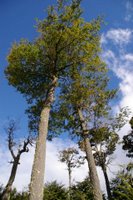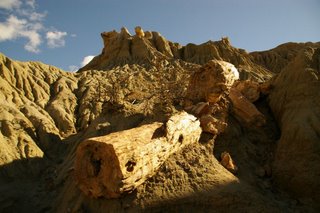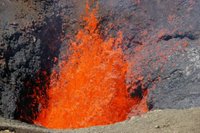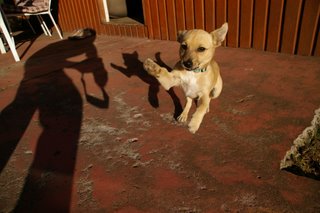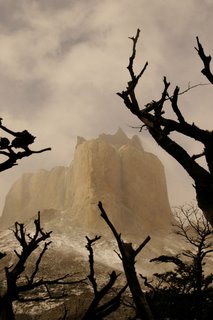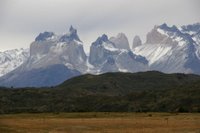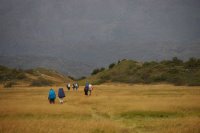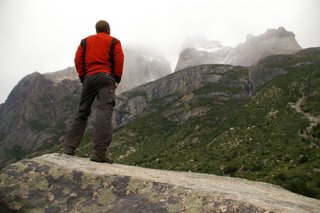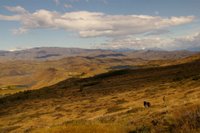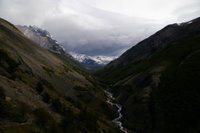The last week Señor Hans has been treated to a surprising number of indigenous Patagonian animals, on land, sea and air. And I can tell you, these beasties are Weird. In the educational light of this blog, I will share all my secret knowledge about them.
 Pampa Moose - Alces Pampitus
Pampa Moose - Alces PampitusMost common of all the pampa dwellers is the Pampa Moose, a smaller relative of the Pampa Cow. The Pampa Moose spends its time running through the Argentinian pampas, eating pampa grass, or looking up from eating pampa grass at passing pampa vehicles. Its speed is only matched by its stupidity.
 Rabbit Dog - Canis Oryctolagus
Rabbit Dog - Canis OryctolagusThe Rabbit Dog is half rabbit, half dog. Although small, the size of a cocker spaniel, it is a ferocious animal. With white foam from the mouth, it attacks everything in sight, often to its own demise. When bitten by the Rabbit Dog, your ears will start to grow upwards.
It cannot reproduce itself, but is the numerous offspring of the many street dogs and rabbits around the Patagonian towns.
 Desert Turtle - Cuteus Maximus
Desert Turtle - Cuteus Maximus
The main talent of the desert turtle is sneaking up on unsuspected tourists, who are scanning the sea for presumably more interesting wildlife. After a round of photo taking and receiving comments of the "Oh, how cute!" variety, it starts attacking wildly (Germans first). It can cleanly bite the leg off a an adult European male and has been known to jump for heads as well.
 Atlantean Condor - Condor Atlanticus
Atlantean Condor - Condor AtlanticusThe formerly mythical Atlantean Condor was first described by Plato, in his description of Atlantis. It has not been verified until Señor Hans, in March 2006, produced the first photographed specimen (see right). It has titatic proportions; with an estimated wing span of 100m, it was seen toppling ocean liners and cruise ships. It is presumed that it feeds on the whales and orcas that populate the Atlantic waters of Patagonia.
 Sea Tenor - Mirounga Pavarottina
Sea Tenor - Mirounga PavarottinaThe Sea Tenor is the singer of the southern seas. Both males and females grow up to incredible blubbery size to facilitate their never ending sea songs. Depite the flirtatious nature of the singing, they mate for life - a rare occurence in South America - with one litter of pups per year, who enter the world singing as well.
 Argentinian Road Runner
Argentinian Road Runner -
Fastius Tastius/Accelleratti Incredibus/Velocitus TremenjusThe Argentinian Road Runner is the fastest land animal in South America. Although a bird, it cannot fly, but runs at tremendous speeds. It characteristically starts its running sessions with a´meep meep´sound and a stuck out tongue. What is left after that, is a trail of dust clouds and a blur in the distance.
 Patagonian Duck
Patagonian Duck -
Anus Patagonicus Señor Hans´s most favourite animal in these parts, the Patagonian Duck is the smartest of all South American animals. Its main tactic to fool its predators is pretending to be a lawn ornament, either standing up or lying down flat on the belly (pretending to be blown down by the strong winds). It is hugely successful in evading its predators this way, mainly because it has none.
They can teleport for up to 100 meters three times a day.
PS. For the not so easily fooled, the Pampa Moose is a Guanaco, one of the four types of Llama. The Rabbit Dog is called a Mara, and it is really a dog-sized rodent. The Desert Turtle is an Armadillo (Gordeldier in Dutch). The Sea Tenor is an Elephant Seal (Zee-olifant). The Argentinian Road Runner is called Rhea or Nandu here, and is related to the Ostridge (Struisvogel) - thanks to Sander & Maartje for the Roadrunner cartoon idea. The Patagonian Duck ... well ... is the Magellanic Penguin and finally, the Atlantean Condor ... is for real ;-P
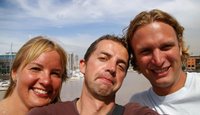 (So people in Holland: be nice to them when they get back tomorrow). I myself will hop into Uruguay tomorrow for a few days of beach relaxation to return later in the week for more of Buenos Aires´ delights
(So people in Holland: be nice to them when they get back tomorrow). I myself will hop into Uruguay tomorrow for a few days of beach relaxation to return later in the week for more of Buenos Aires´ delights



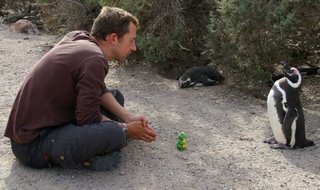
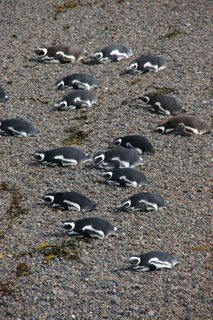

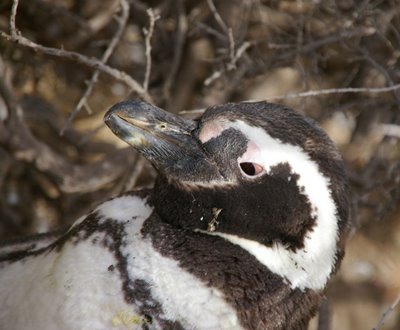

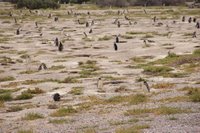





 Atlantean Condor - Condor Atlanticus
Atlantean Condor - Condor Atlanticus









